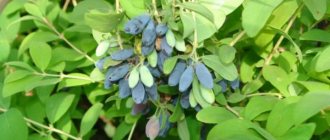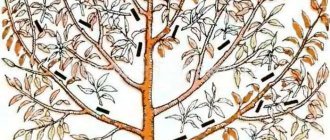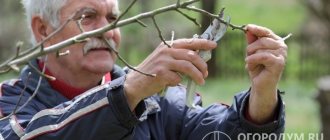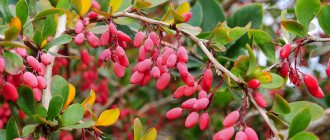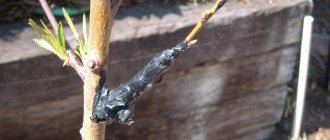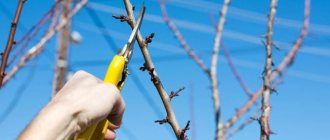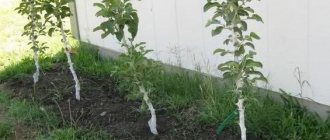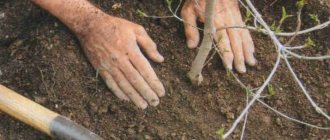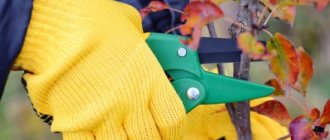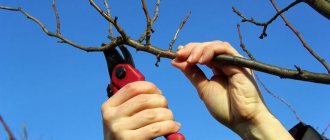What does pruning do and why is it necessary?
The formation of a plum crown creates a powerful tree frame that can withstand the load of the harvest. The main requirement of this stage is the selection of skeletal branches and provision of conditions for their development: sufficient lighting and a high level of mineral nutrition of the tree. There is no need to rush into forming branches of the following orders.
Timely and correct tree pruning contributes to a rich harvest
Note! Only after the formation of skeletal branches can you begin to grow fruit wood.
When the frame grows, cupping will stimulate the growth of fruit formations - fruitlets and bouquet branches. All varieties show good responsiveness to this agricultural practice.
When to trim branches and shape the crown
Sometimes gardeners disagree about when to stop drainage. But, after analyzing the advice of many experienced gardeners, it is necessary to come to the conclusion that cutting and, therefore, crown formation is necessary only in the spring. This is mainly due to the following important points:
- Fall runoff cuts lead to slow healing of intersections;
- Pruning branches in the fall leads to the possibility of frost in winter, which can lead to tree diseases;
- The spring cut of the drain must be performed before the intensive process of juice movement begins;
- in the spring the tree will be easier to cut down.
Types and techniques of plum pruning
Pruning plums in summer and how to do it correctly
As trees grow and develop, the following types of pruning are used:
- formation – selection of branches of the first and second order;
- shortening - used for the central conductor and lateral branches in order to create a balance of growth force, carried out obliquely over the kidney. A type of shortening is crowning; it is used to give the tree a geometric shape and an aesthetic appearance;
- cutting “into a ring” – used for excess, thickening branches and vertically growing tops;
- methods of regulating pruning for fruiting - blinding, pinching (pinching) and kerbovka.
You need a sharpened pruner and a garden saw; an electric saw is suitable for crowning.
Basic principles of proper crown formation
There are several rules to follow during the procedure:
- deadlines;
- neat cutting;
How quickly the wound heals depends on the correct cut. The diagram shows the correct cut of a branch into a bud and the mistakes made by inexperienced gardeners.
- well-sharpened and sterilized instruments;
- final treatment of sections with garden varnish or any disinfectant.
Scheme of rejuvenating pruning of an old tree with a height limitation
Plum cluster blight - how to treat leaves in a hole in a plum
Rejuvenation is carried out on trees older than 15 years. Start with a height limit. The central conductor is cut down to 2.0-2.5 m from the ground.
Rejuvenating plum pruning
Excess shoots of the second order are completely removed. To stimulate the growth of fruit branches, 7-8 branches of the second order are sufficient. They are subordinated to each other in height and length.
Note! Unlike cherries, plums “forgive” mistakes and pruning them is a good lesson to practice and consolidate your skill.
Selecting a location
Plum is the case when care and attention is required from the very first days of planting. All the gardener’s efforts are rewarded with large harvests of beautiful juicy fruits, which are good fresh and are also great for home canning.
Since the plum itself is a heat-loving plant, it is important for it that there be good warm weather during the flowering period. Otherwise, frost can destroy all the flowers.
To minimize this risk, plums do not need to be planted in lowlands, where frosts occur first. Usually, elevated places are chosen for plums, with plenty of sunlight and where there is no access to north winds.
When planting, be sure to maintain reasonable distances from buildings, fences, and other trees. Be sure to take into account that an adult plum will have a spreading, lush crown. There is no need to plant other fruit trees very close - the plum takes a lot of moisture and nutrients from the soil.
If groundwater is too close to the surface, it can be detrimental to the drain. In the place where you plan to plant it, the water should lie no closer than 1.5 m.
Regulatory plum pruning for fruiting
On plants older than 5 years, the buds produce shoots that grow vertically; they bear few fruits. A technique that inhibits vegetative growth is a kerbovka or an oval incision in the bark under the bud, from which it is supposed to form a fruit-bearing shoot. The opposite situation, when there are many dormant buds, will require cutting the branches above the bud.
Kerbovka of shoots and its types
The formation of a plum, its bole and too frequent arrangement of branches require blinding, manual removal of excess buds and green shoots of the current year. Pincer treatment will be needed in the summer. It consists of pinching the tips of growing branches in order to improve the nutrition of the buds and lay flowers in them.
Rejuvenation
Rejuvenating pruning is carried out when the growth of new branches dies down.
The bouquet twigs of plums, after bearing fruit for 3–4 years, dry out. The branches become bare. New bouquet branches are formed on good young growths.
But over the years, the shoots grow shorter and shorter, and fruiting shifts to the periphery of the crown; productivity decreases.
In the same way, neglected old plantings are corrected, at the same time cutting off the top.
Bushy plums are periodically rejuvenated by regrowth, completely cutting out the old stems. Such plants can bear fruit for more than half a century.
Scheme for pruning plums in spring
In the southern regions, a leader and sparse-tiered formation is performed, in the north - a bowl.
Note! The cup-shaped crown is better illuminated by the sun, and the fruits become sweeter.
Leader formation
Step-by-step instructions on how to form a homemade plum tree look like this:
- In the second year, you should select a central shoot and three skeletal branches located at an angle of 120 degrees to each other. They need to be cut to the same height. The leader must be subordinated 20 cm above the skeletal branches. Remove the remaining shoots completely.
- In the third year, the plum tree, which begins to bear fruit, becomes heavily overgrown with branches. It is necessary to remove everything that grows downward, inside the crown, and intersects with each other.
- In the fourth year, the leader is transferred to a strong branch, the tops are removed on the plum, and the remaining branches are shortened for subordination.
Leader plum formation
Vase or bush formation
When forming a plum tree into a wide bush, three skeletal branches are selected, the trunk above the top branch is removed. In the future, they practice shortening the branches.
Vase shape
Sparse-tiered formation
To understand how to form a sparsely tiered plum crown, you should know its differences from the leader one. Up the stem, 30-40 cm from the first tier, 2 branches should be left. They should be directed approximately in the center between the shoots of the lower tier. Later, branches bearing fruits grow on them.
Care after pruning
After the event, the tree especially needs strength to restore and heal wounds, so it is necessary to feed it with phosphorus, potassium or nitrogen fertilizers according to the instructions on the preparations. For proper growth, the plum must be sprayed with a solution of saltpeter and urea. The lack of any valuable element is manifested by external signs.
So, with a nitrogen deficiency, plum leaves become significantly lighter. A brown tint to the foliage indicates a lack of magnesium and potassium. Caring for the tree also involves regular, abundant watering with a soil moisture depth of at least 40 cm. In autumn, at the end of the season, much less watering should be done. If possible, it is enough to equip a drip system that ensures a constant supply of moisture to the roots of the tree. In winter, watering is usually not required.
In January, you can already start preparing materials and equipment for future spring work. Since plums are often attacked by aphids and black ants, in the fall after harvesting they should be treated with special preparations. As folk remedies, you can use onion peel tincture, a solution of garlic with laundry soap, wormwood or a solution of urea.
Formation of plum by age
How and when to form a plum correctly depends on the age and strength of growth:
- Trimming an annual tree. It is performed in the summer in the form of pinching with increased shoot growth. Not recommended in northern regions.
- Pruning a two year old tree. Performed in the spring, it is aimed at forming branches of the second tier and order. Shortening is applied.
- Pruning an old plum tree. Performed in spring and autumn in the form of sanitary and anti-aging pruning. The central leader is cut to reduce the height of the tree.
- Trimming a neglected plum tree. Performed at any time of the year. It consists of sanitary, rejuvenating and shortening pruning.
- Pruning columnar plum. It involves removing branches that compete with the central shoot. The side branches are shortened annually by 1/3 of their length.
How to trim a yellow plum
Plum of this type requires strict adherence to pruning rules, because pruning, for example, Karzinsky can lead to a decrease in fruiting. And the Ussuri will lose little with any haircut. The branches are cut down in this way:
- In the first season after a decrease in yield, all weak, damaged, and pest-infested branches are pruned.
- In the second year, the conductor and strong healthy shoots are reduced.
- In the fall, they do not trim for the purpose of rejuvenation, but prepare the tree for winter - remove diseased, damaged, weak parts of the branches.
Method of bending branches
Bending down the branches is carried out in May; if you postpone the procedure until the summer, the results will only appear in a year.
Bending down branches is used to speed up the entry of seedlings into fruiting. The procedure allows you to get a harvest 2-3 years ahead of schedule.
1 – bending the branch into a horizontal position; 2 – formation of fruit shoots; 3 – branch fruiting.
Execution technique
- The main shoots are deviated from the trunk at an angle 50–60°.
- Small branches are placed horizontally (at right angles to the trunk).
- It is necessary to ensure that the ends of small shoots are located slightly above the beginning of the skeletal branch.
When tying ropes, do not pull the branches too tightly!
- The main branches should not form an arch when bent.
To bend the branches you will need wire or twine , as well as rubber gaskets that will protect the bark from chafing at the attachment points.
